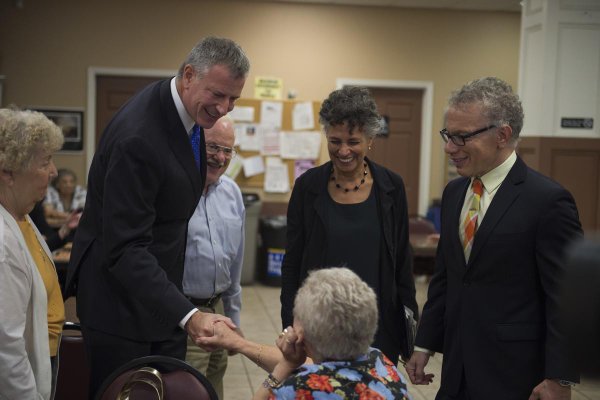
Mayor de Blasio visits Bronx seniors (photo: @BilldeBlasio)
If there was available land to build affordable senior housing across the city, would you use it? There is. And we must.
The key to using it is passing the de Blasio administration's Zoning for Quality and Affordability plan, which calls for independent senior buildings. There are several reasons this plan makes sense for New Yorkers, of all ages.
LiveOn NY, a leading advocacy organization for older New Yorkers, released Paving the Way for New Senior Housing in May, identifying feasible land that could house 2000 New Yorkers. The city needs to a plan to move forward now - at a certain age, you can't wait.
Why are seniors constantly calling their local City Council members and other elected officials, desperate for affordable housing? Older New Yorkers, the fastest growing demographic in New York City, will comprise an estimated 1.84 million city residents by 2030. Senior households are smaller and poorer on average than the general population. About one in five older New Yorkers live in poverty (below $11,170/year) with many surviving on Social Security alone.
How are seniors impacted by the housing affordability crisis? A shocking 65 percent of senior households living in rent regulated housing, including thousands on SCRIE, spend more than half their income on rent. For those in unregulated buildings the burden is greater. Insufficient affordable housing forces seniors to remain isolated in unsafe or inappropriate housing. This includes living on upper floors of walk-ups or in spaces unable to accommodate a wheelchair.
Tens of thousands of seniors languish on waiting lists in Section 202 buildings for 5-10 years. There are waiting lists to get on waiting lists as primary lists are closed. There are no waiting lists for parking. The choice seems obvious.
Why is utilizing 202-building parking lots one part of the solution to the affordable housing crisis? Land scarcity is the greatest challenge confronting senior housing providers. In the face of a dwindling stock of city-owned land and soaring acquisition costs, 202 parking lots are an untapped source of new land. The lots are owned by local non-profit housing providers mission-driven to provide appropriately sized apartments ensuring senior independence.
Zoning changes would not require eliminating parking, but it becomes a powerful option if in the best interest of the community's elders. Local non-profits have been an integral community partner for decades, providing senior housing and services, and relied upon by local residents and elected officials.
Through the Paving the Way study, LiveOn NY's coalition comprised of leading NYC non-profit senior housing providers, operating 20,000 apartments, found solutions. The knowledge coalition members have of the challenges in building affordable senior housing informed the study. It is critical to understand that the parking lots in question can be used only by residents of the corresponding buildings.
Based on carefully determined criteria, 39 lots in all five boroughs were identified as potentially feasible sites. These sites could be home to at least 2,000 new apartments. With tens of thousands on waiting lists, the potential to house 2,000 seniors cannot be ignored.
Utilizing parking lot land for housing will not take away needed parking spaces. A Department of City Planning analysis found extremely low car ownership rates among 202-building residents, at only five cars per 100 residents in areas near public transportation and 11 cars per 100 residents in areas further from transit.
Many residents have incomes below $15,000 and have aged in place and no longer drive. They are unable to maintain car ownership or have stopped driving. There are waiting lists for apartments; not for parking. Non-profit managers provide vans to assist residents with their daily needs.
Why is the city's Zoning for Quality and Affordability plan necessary to move senior housing forward? Without the enactment of ZQA, the parking lots will sit underutilized - outdated requirements no longer reflect the reality of demand. Nonprofits will be unable to build new housing, whereas ZQA provides options for nonprofits to build more units. It costs $20,000-$50,000 to develop each parking spot. That money could be used for additional apartments, allowing the provider to go deeper into affordability.
Allowing for increased height of one or two floors provides more apartments and ground-floor commercial space. It prevents apartments being on street level, a particularly unsafe practice learned again during Hurricane Sandy.
Accessory amenities are a key component in the neighborhood development approach to keep seniors housed with services. Seniors throughout the community could benefit from using smaller parking lots for medical facilities or senior centers. ZQA facilitates the co-location of services.
How can the city "pave the way" for more senior housing? By enacting ZQA, zoning regulations will be updated to meet the growing need in the coming years and underutilized land – a scarcity in this city – can be used to house 2000 or more seniors.
The need is there. The land is there. Waiting is not an option.
***
Bobbie Sackman is Director of Public Policy, LiveOn NY, a nonprofit organization that makes New York a better place to age. On Twitter: @LiveOnNY.




